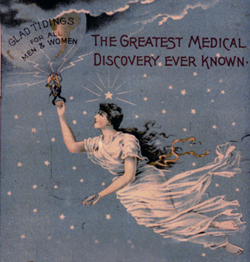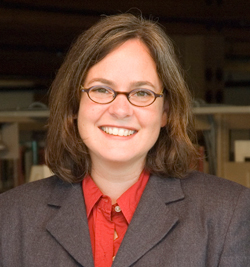
Something for Everyone: Gender & Media Studies at Colby-Sawyer
Professor Melissa Meade opens her Gender and Media class with a straightforward question about a recent screening of the film “Passion and Power.” “Is society still afraid of and uncomfortable with female sexuality, as the film suggests?”
After thinking for a moment, students begin contributing their opinions. Aimee Cates '11 offers, “Confident women who are forthcoming about their sexuality still find themselves placed in the role of 'vixen' or 'black widow.'” The class agrees and moves on to discuss the idea of feminine power and how it's portrayed in the media when Professor Meade brings a recent news headline to attention: “Female Sexuality Still Terrifying to Conservative Lawmakers.”
Politics aside, this present-day headline demonstrates how the idea of female empowerment is still considered dangerous, and that the media has the power to perpetuate these stories and ideas. So begins one of Colby-Sawyer's current “hot topic” courses, one that offers something personal and relevant for every student.
Gender and Media (COM 360)examines how media images play a role in defining male and female gender identities. The course also helps students understand the construction of gender based on the ways race, class, sexuality, femininity and masculinity are portrayed and interact. The students study cutting-edge research and analyze images from the media to determine what society has accepted as normal gender roles, and how these roles can change.
While courses in gender are typically associated with women, issues of gender are pertinent to all people. These issues affect everyone, as Professor Meade explains. “When we think of gender studies, we often think of the history and analysis of women and femininity, but masculinity is also part of the equation,” she says. “Theorizing masculinity as well as femininity is crucial for the feminist project.”
Gender and Media, which has always been a popular course, is seeing increasing enrollment due to the common subject matter. Students participate in cultural analysis case studies and use analytical skills and theory to understand the implications of media on their gendered lives.
Due to the current nature of the topics and research in the course, students are able to put their knowledge to immediate use in real-world settings. Meade explains, “I often have conversations with students about the material outside of class. My office hours are always full! We talk about gender in popular music, in political media discourse, in the movies, in contemporary social movements, and in their everyday lives.”
Because Gender and Media is a contemporary course that relates to ongoing social movements, it sometimes hits on “hot topics” that spark debate both in and outside of the classroom. One student recalls an experience with her parents while she was telling them about her course schedule for the spring semester. When she briefly described Gender and Media, her parents became uncomfortable and jumped to the conclusion that the course was “just about sex": her parents were unable to see the course's subject matter outside of a sexual context. She explained that, while the course often deals with sexual roles perpetuated by the media, it also covers broader concepts that everyone can relate to.
Aimee Cates was also surprised to find that outdated notions about gender and sexuality, like the ones expressed by her fellow classmate's parents, still existed. “This course surprised me with the stereotypes of men and women, as well as LGBT, that were created years ago and are still widely accepted today.” She continued, “I am beginning to see gender studies as not just based on feminism, but on overall equality instead. With this gender equality we also enter into LGBT rights and the study of both genders and their search for equality.”
With the course's universal accessibility, Professor Meade has noticed an increase in the number of male students enrolling in Gender and Media. “People might be surprised to learn that I have encountered quite a few male students in the women's studies curriculum,” she explains.
During classroom discussions in Gender and Media, which range from observations and opinions of Burt Reynolds' well known 1972 Cosmopolitan centerfold to analysis of the continued objectification of women in advertisements, male students contribute a good portion of the discussion. They even argue that, while women have always felt affected by the gaze and pressures of society to be thin, beautiful and sexy, they have felt increasing pressure from the media to be strong, fit and handsome.

With the popularity of advertisements like David Beckham's underwear campaign for Emporio Armani and the popular “GTL: Gym, Tan, Laundry,” mantra of the male cast members of “Jersey Shore,” men everywhere are hearing demands to be buffer than ever. Students in Gender and Media unanimously agreed that even Colby-Sawyer men feel the effects of this pressure. The numbers of men lifting in the Hogan Sports Center has increased significantly in the last academic year, as one male student explains: “There are a lot more guys putting time in at the gym this year, and the muscles are getting a lot bigger.”
The overall enthusiasm for the course and subject matter is apparent in students' class participation. During the semester, each student is required to lead a seminar on course topics and research. The presentations can last the duration of a class session, fueled by discussion and thoughtful debate among classmates.
Leah Hodder-Romano '12 enjoys the discussion that Gender and Media generates, and feels it's important for people to talk about current social issues. She summarizes the course as “broad, brave and reflective.”
Those three words perfectly describe Gender and Media, as the course is brave enough to look at current media-perpetuated gender roles that have a profound effect on everyone's lives, reflective enough to decide if and how these issues should be changed, and broad enough to provide subject matter that captures the passion and attention of everyone enrolled in the course.
-Jessica McLavey '10


